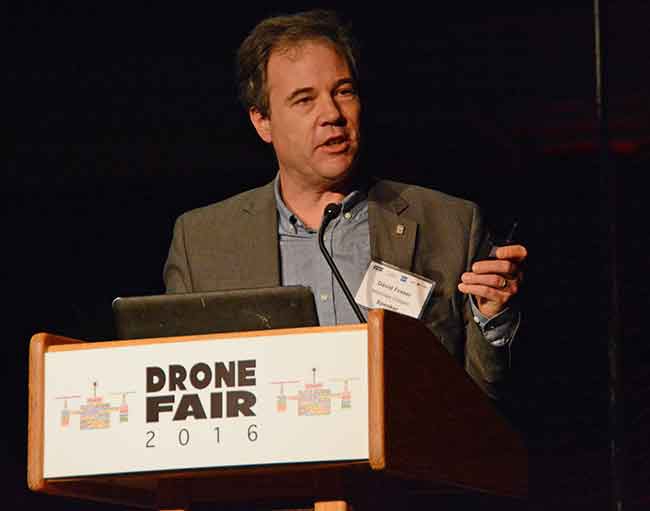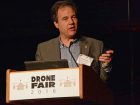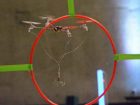
Features
Innovations
UAVs
Drone Fair 2016 impresses in B.C.
March 15, 2016 By Paul Dixon
A bright, sunny day couldn’t deter an overflow crowd that descended on the Sportsplex at BCIT’s main campus in Burnaby, B.C., for Drone Fair 2016, Saturday Feb. 20.
 David Fraser from law firm McInnes Cooper. Fraser is one of Canada’s foremost legal experts on privacy issues. A bright
David Fraser from law firm McInnes Cooper. Fraser is one of Canada’s foremost legal experts on privacy issues. A brightThe first of its kind in Western Canada, the fair brought together vendors, operators and regulators under one roof to talk about the latest developments in the rapidly expanding drone/UAV industry, as well as the regulations governing how and where drones can be safely operated. Co-organizer Declan Sweeney described the event as educational, an opportunity to highlight the positive side of drones in light of negative media reports.
Safety and the regulatory environment were a major feature in the speakers program. “Drones are aircraft,” Sweeney said, “and they fall under the same rules as ordinary manned aircraft.” Sweeney’s comments were echoed by Eric Edwards of Unmanned Systems Canada, who talked about popular misconceptions about the rules and regulations governing the use of drones.
“The rules are very clear,” Edwards said. “Whatever you are doing, it is still aviation.” The message both presenters conveyed is susinct – get proper instruction in the operation of your machine, understand the regulations you are operating under and get the proper certification if required. The message from Transport Canada was simple and straightforward – know before you fly, because whether you are flying recreationally or commercially, you are expected to operate your aircraft safely and legally.
Professor David Bird of McGill University gave numerous examples of the utility and versatility of drones in assisting research biologists in wildlife studies around the world. Two examples he noted were tracking caribou across the Arctic tundra or polar bears far out on the ever-thinning arctic ice flows. Locating radio-beacon equipped song birds in B.C.’s Gulf Islands or puffins in their colonies on the rocky shores of Newfoundland is also being carried out by drone techology.
Drones are also providing an unobtrusive eye in the sky over Africa to gather information on endangered species as well as the poachers that are driving them to the brink of extinction. Increasingly, drones are becoming the tool of choice for wildlife researchers, because they offer a degree of stealth not possible with manned aircraft and are far more cost-effective. Even more importantly, drones are much safer, as Prof. Bird reports. The leading cause of death for wildlife biologists in the field has been aircraft of helicopter crashes.
Justin Hannewyk of HeliVideo Pros gave an overview of the evolution of drones and filmmaking. A decade ago, the use of drones in the movie business was limited to a handful of major Hollywood productions – as in Bond, James Bond and the Harry Potter movies. Airborne cameras were bulky and the unmanned aircraft were difficult for even the most skilled operators. Today, with the advances in digital cameras and drone technology, anyone can shoot movie-quality HD video with their own small, hobby drone.
The mainstream media has made much of privacy concerns around drones, as discussed by David Fraser of the McInnes Cooper law firm. A self-described technology geek and drone enthusiast, Fraser is described as being one of Canada’s foremost authorities on privacy law. He used spoke of earlier technologies – the telephone and the Kodak Brownie camera as two examples and the concerns raised about potential invasion of privacy back in the day. There are a number of statutes that deal with privacy and trespass and while none of them specifically address the issue of drones, there are elements of these various pieces of legislation that may apply. As the operator, it is incumbent on you to be aware of what you are doing.
One of the major stumbling blocks at the moment is the common perception of just what a drone is. Most people, when asked to describe a drone will focus on something like the Global Hawk or Predator, when the reality is that the domestic drone market is overwhelmingly comprised of small, hobby-size drones. A problem with creating specific privacy legislation to address drones is that by the time legislation is drafted and adopted by government technology will have moved several steps ahead, creating new issues that were never contemplated.
The semi-main event was the University Challenge – four university teams competing for a $2,500 scholarship donated by DJI/Flying Camera. The teams had to build their aircraft in the morning and then fly them through a skills course in the afternoon. First up in the skills test was an update to the old coin-operated claw machine, where the operator was required to fly their drone to a table and successfully use a grappling hook suspended from the belly of the drone to pick up an object and successfully fly away with it.
Only one team was able to complete the mission within the time allotted. The second test required the operator to fly their machine back and forth through a hoop as many times as possible in a minute, while battling simulated extreme weather conditions provided by a battery of large fans. Simon Fraser Team Guardian reigned supreme, taking their success in the first segment and zipping back and forth through the hoop to the frustration of the competition to a rousing ovation from an enthusiastic crowd.
The grand finale was the Drone Fair Grand Prix, where eight local pilots competed in a series of heats through a course set up inside a large net on the basketball court of the BCIT Sportsplex, much like the Reno Air Races in miniature. Pilots and their machines paraded across the circuit before the multitudes. Spectators were cautioned not to get too close to the protective netting “just in case” and then with the toot of an air-horn the first heat was up and away.
Like killer bees on the loose, the mini-machines snarled around the course, bobbing and weaving like hummingbirds jumped on caffeine. The first heat ended peremptorily when two of the might mites sailed off into a cement wall. Think frog-in-a-blender meets bug-on-a-windshield. Proponents of drone racing are suggesting that in the near future the sport will be as popular as NASCAR, but it appears there is still a long way to go. As they say in Mexico, “manana,” which translates as definitely not today and probably not tomorrow, but maybe one day.

